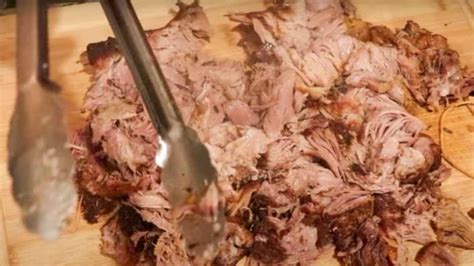How Long to Rest for Fall-Apart Pork Shoulder? The Ultimate Guide to Juicy Perfection
The aroma of slow-cooked pork shoulder, meltingly tender and bursting with flavor, is enough to make anyone's mouth water. But achieving that "fall-apart" texture isn't just about the cooking time; it's also crucially about the resting period. Understanding how long to rest your pork shoulder is the key to unlocking unbelievably juicy and flavorful results. This comprehensive guide will delve into the science behind resting meat, explore different resting methods, and help you determine the optimal resting time for your perfectly cooked pork shoulder.
Why is Resting Your Pork Shoulder Important?
Resting meat, especially a large cut like a pork shoulder, is not simply a matter of convenience; it's a critical step in achieving optimal tenderness and juiciness. During cooking, the muscle fibers contract, squeezing out precious juices. Resting allows these juices to redistribute throughout the meat, resulting in a more tender and flavorful final product. Think of it as allowing the meat to reabsorb its own deliciousness!
How Long Should You Rest a Pork Shoulder?
The ideal resting time for a pork shoulder depends largely on its size and cooking method. Generally, you should plan on resting your pork shoulder for at least 30 minutes, but up to 2 hours is often beneficial for larger cuts. The longer the resting time, the more the juices redistribute. However, over-resting can lead to slightly cooler meat, so finding that sweet spot is key.
For a pork shoulder weighing around 5-7 pounds, cooked using a low-and-slow method (like smoking or braising), a resting time of 45-60 minutes is usually ideal. Larger shoulders (8 pounds and up) may benefit from a longer rest of 1-2 hours.
What Happens if You Don't Rest Your Pork Shoulder?
Skipping the resting phase can result in a dry, tough, and less flavorful pork shoulder. The juices that escape during cooking will simply run out, leaving you with a disappointing meal. The difference between a properly rested and an improperly rested pork shoulder is dramatic.
Different Resting Methods for Pork Shoulder
While the basic principle remains the same, there are different ways to rest your pork shoulder:
-
Resting in the Cooker: If you're using a slow cooker or Dutch oven, you can simply turn off the heat and let the pork shoulder rest in the residual heat for a period of time. This is a convenient method, but it's important to remember that the residual heat will continue to cook the meat slightly.
-
Resting on a Cutting Board: This is the most common method. Once cooked, remove the pork shoulder from the cooker and place it on a cutting board, loosely tented with foil. This allows for some air circulation while retaining moisture.
-
Resting in a Cooler: This method is especially useful for larger cuts or when you need to keep the meat warm for an extended period. Wrap the pork shoulder tightly in foil and place it in a cooler. This will help maintain its temperature while allowing it to rest.
How to Tell if Your Pork Shoulder is Done Resting?
The best way to tell if your pork shoulder is done resting is to check its internal temperature. Use a meat thermometer to ensure it reaches a safe internal temperature of at least 190°F (88°C). The meat should be incredibly tender, pulling apart easily with a fork.
People Also Ask (PAA) Questions:
How do I keep my rested pork shoulder warm?
To keep your rested pork shoulder warm, you can use a cooler, as mentioned above. Alternatively, you can loosely tent it with foil and place it in a preheated oven set to the lowest temperature. This will help maintain its warmth without overcooking it.
Can I over-rest a pork shoulder?
While it's unlikely you'll completely ruin the meat by over-resting it, excessive resting can lead to slightly cooler meat. Aim for the suggested resting times and use your judgement based on the size of your shoulder.
What's the difference between resting a pork shoulder and other meats?
Pork shoulder, being a larger and tougher cut of meat, benefits more significantly from a longer resting period compared to smaller, leaner cuts like chicken breasts. The longer rest allows the collagen to break down and the juices to redistribute more effectively.
My pork shoulder is still tough after resting. What went wrong?
If your pork shoulder is still tough after resting, it may not have been cooked to the proper temperature. Ensure it reached an internal temperature of at least 190°F (88°C). Also, consider the cooking method and whether enough time was allowed for the collagen to break down.
By following these guidelines and understanding the science behind resting your pork shoulder, you'll be well on your way to consistently creating succulent, fall-apart pork that will impress even the most discerning palates. Remember, patience and attention to detail are key to achieving that perfect, melt-in-your-mouth texture!

